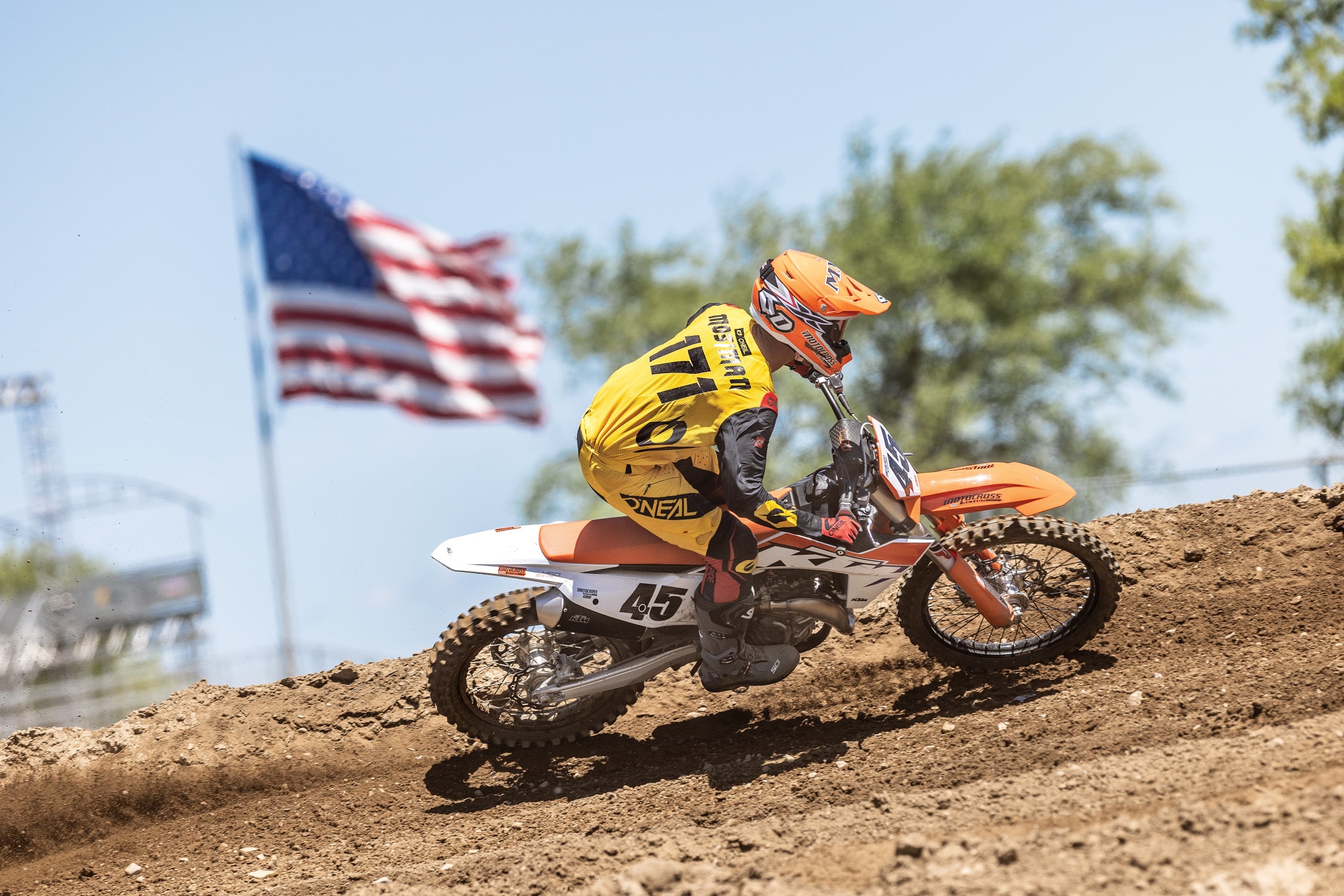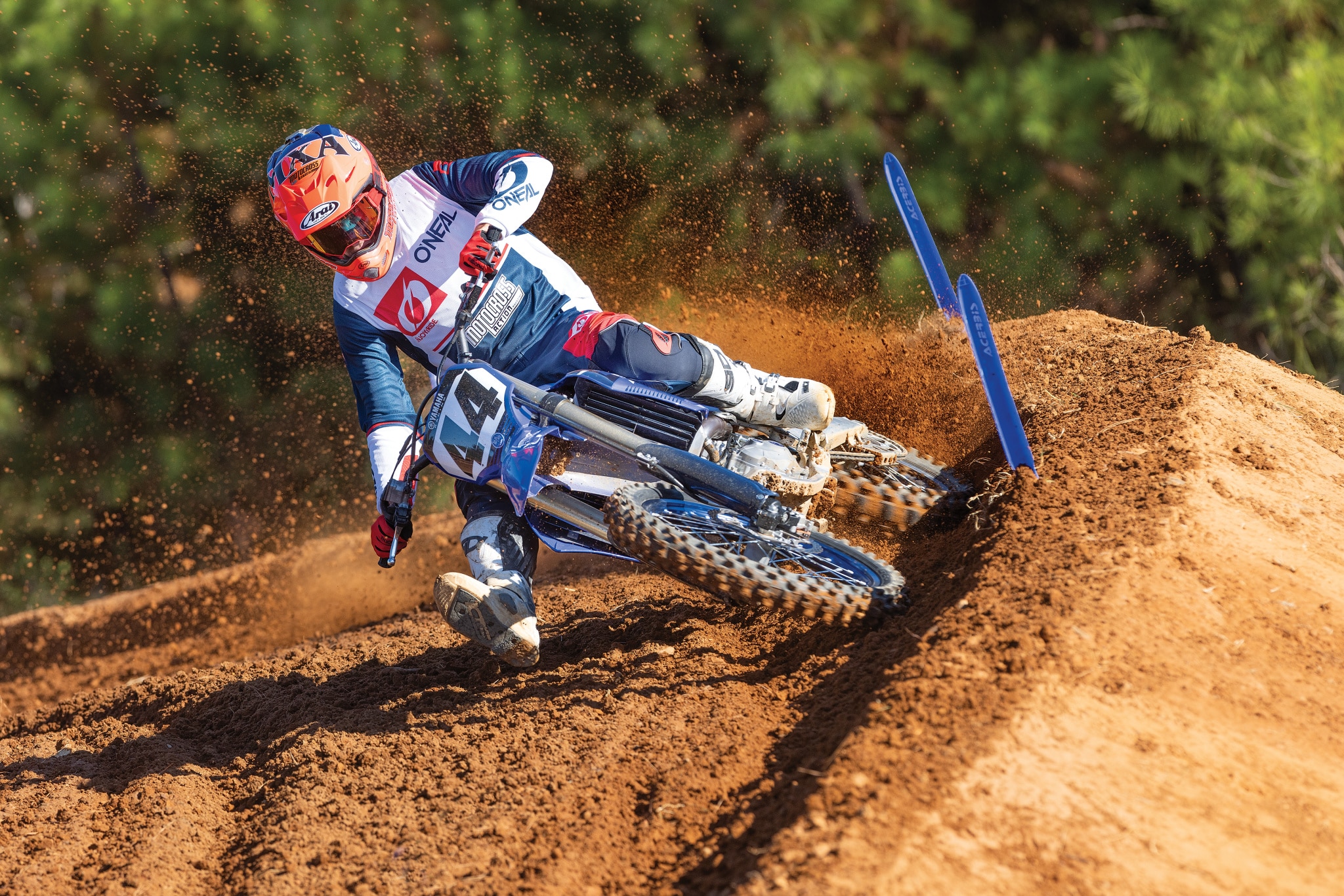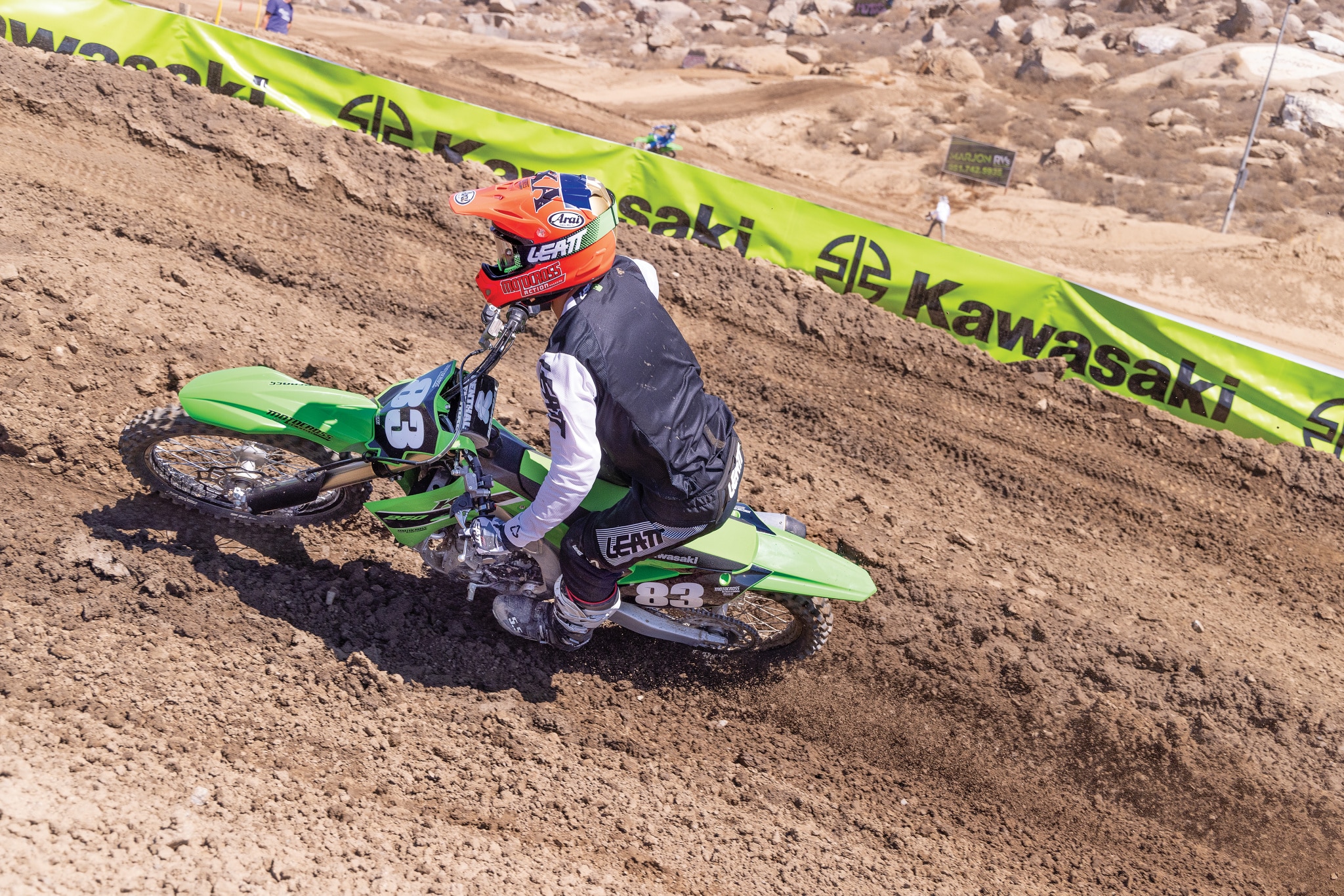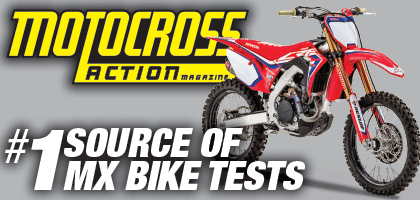MXA SPEED SECRETS: BODY POSITION & THE ART OF BIKE HANDLING
 The “attack position” of the 1980s is being replaced by the “coiled position.”
The “attack position” of the 1980s is being replaced by the “coiled position.”
In the early days of motocross, riders kept their body weight as far back as humanly possible. Viewing old race footage reveals some of the greatest stars of the sport sitting on their rear fenders. Why did they stay so far back? The ergonomics of the bikes they raced demanded it. With limited suspension travel, short wheelbases and archaic forks, the riders from the 1970s sought the safety of the driven rear wheel.
In the ’80s, riding styles began to change. As suspension travel began to increase in the late ’70s, motocross racers began to move forward. By the mid-’80s, the popularity of the “attack position” slowly but surely moved the motocrosser over the front of the bike. Today, the attack position still exists, but it has been replaced by an emphasis on being one with the bike. The coiled position is the new goal of modern motocrossers.
 In the last half a decade, the majority of the Japanese brands have gone to steeper head angles to improve cornering at the expense of feeding in some head-shake at speed.
In the last half a decade, the majority of the Japanese brands have gone to steeper head angles to improve cornering at the expense of feeding in some head-shake at speed.
BE A CENTRIST AS OPPOSED TO A LEFTIST
Although body position is relative to the angle of the bike in relationship to the horizon, the modern rider’s centered position is no longer in the center but closer to the front wheel. Why?
Front suspension: Modern front fork design, stiffer spring rates, and effective anti-bottoming devices allow a modern rider a greater margin of safety than the old-fashioned, oil-damped, 6-inch-travel forks of the ’70s.
Frame geometry: Steeper geometry has forced the rider to weight the front of the bike in order to magnify bite. Bikes of 25 years ago had slack 31-degree head angles, rearward weight biases and low centers of gravity. New bikes are taller, weighted more to the fore and tippy. Staying forward helps counterbalance the new, steeper, 27-degree geometry.
Tracks: Modern track designs have drifted away from fast, sweeping corners and moved towards tighter Supercross-style turns, often with deep ruts or berms (made deeper than in the past by long-travel suspension). Since staying forward enhances cornering, modern riders have been drawn to the front by the complexity of modern track designs.
BE FLEXIBLE AND BE FAST
Body position is determined by terrain, vehicle output and rider input. When going up a hill, a rider will always move forward to counteract the rearward weight shift. If he doesn’t, there is a wheelie in his future. Downhill riding demands that the rider move rearward to compensate for fork compression, weight shift and gravity. Apart from terrain changes, the attitude of the bike also affects rider positioning. The difference between hard braking and hard acceleration highlights the obvious direction in which the rider must move to compensate for natural forces on the chassis.
As a rule of thumb, you should pull yourself forward in the corners and allow G-forces to help you return to the center under acceleration. The Gs will hold you in place, as long as you aren’t in the wrong place to begin with. When you are out practicing, take note of where you sit, then try to sit an inch or two farther forward. It is easier to move back in an emergency than it is to move forward.
Your motorcycle, along with everything tangible on this planet, has a center of gravity. In engineering terms, it’s simply called the “CG,” but it could be called the “balance point.” Motocross chassis designers go to great lengths to place the engine, wheels and suspension components in exactly the right location to get a motocross bike’s CG perfect.
The higher the CG is located on a motorcycle, the more likely it is to have handling issues that only the rider can fix. Paradoxically, you will be horrified to discover that the CG of a modern motocross bike is purposefully high—way high, way too high; however, it is only too high when the bike is vertical and stationary. For a machine that is required to skim across the earth, fly through the air and swivel about its CG, a high center of gravity is a plus.
One of the tools of any motorcycle racer is weight transfer. It makes a 230-pound machine feel light or heavy depending on what the situation calls for. When a motorcycle accelerates forward, the bike rotates around its CG, causing the front tire to get light and weighting the rear tire. Because of this weight transfer, there is a heap of traction on the back tire when a racer needs it most—roosting out of a corner. The downside of this is that when a bike decelerates, the motorcycle’s mass rotates towards the front wheel, and it is possible for the rear wheel to lift, kick or bounce. This dance of fore and aft weight transfer is the root of going fast, but the rider has to be able to move in sync with his constantly changing world. When a bike accelerates, it is a different machine from one that is braking. When it flies through the air, it requires a different body position than when it is buried deep in a berm.
PUT A LOAD ON IT
One of the things that 1970s motocross racers did better than the modern crew was to load the outside peg. When you change directions, the angle of that change and the speed you are traveling create an imaginary angle called a “force vector.” Any time you enter a corner, land sideways from a jump or swap ends in the whoops, you are trying to convert inertia (force stored by a mass moving along a straight line) into lateral acceleration (the G-forces that we feel in a turn). This change in direction creates a force vector, a line of equilibrium between the two paths.
 Weighting the outside peg is best achieved by pressing your knee against the gas tank.
Weighting the outside peg is best achieved by pressing your knee against the gas tank.
To arrive at this imaginary force-vector angle, you divide how many degrees you deviate from a straight-line course in half. The resulting angle happens to be exactly how much you need to lean a motocross bike to counter the cornering forces. For instance, a 90-degree change in direction requires a 45-degree lean angle. As long as your center of gravity and that of the motorcycle’s are balanced at an angle that matches the force vector, you will remain in control. When your lean angle is perfect, traction is at its peak, because you expose the largest possible area of your rear tire to the dirt. If you lean too far (beyond 45 degrees relative to the surface of the track), you angle your wheels onto the edge of the tires, revealing an ever-smaller contact patch. Because the rear tire bears 60 percent of a motocrosser’s weight, even a small loss of traction will cause a loss of control.
Any lean angle more than the force vector reduces the available traction and causes the bike to want to low-side (slide out). Any lean angle less than the force vector moves the motorcycle’s center of gravity to the outside of the corner and into the dreaded high-side zone. What typically causes a high-side? (1) Tightening the radius of the corner at the last second. (2) Shifting your weight too far to the outside of the optimum lean angle. (3) Entering a turn with too much speed to be countered by lean angle.
But, a smart rider puts an added degree of bite back into his tires by weighting the outside peg. The outside peg is the one opposite of the direction you are trying to go. By putting pressure on the outside peg, a rider can shift a huge amount of weight to the outside of the bike, which improves traction and control.
How can you get all of your weight on the outside peg? By pressing your outside knee against the gas tank and using it as a brace to press down on the peg. In conjunction with the loading of the outside peg, you need to unload the inside peg. Take your inside foot off the peg and allow it to swing, in much the same way a tight-rope walker uses his pole to find the balance point. In a pinch, you will even see riders scooch over on their saddles to get more weight on the outside of the tire.
COIL LIKE A SNAKE
The key to moving forward and backward on the bike is to be flexible, and the key to being flexible is standing up whenever the bike is dancing through bumps, skating into corners or flying through the air. From a purist standpoint, the only time a rider should be sitting is when he is in the middle of a corner. The perfect riders, of which there have been very few, stand around 90 percent of the track and only sit when maximum traction is required to initiate a turn. In sequence, it is: (1) Stand as you approach the corner. (2) Stand and lean forward as you enter the corner. (3) Sit just before the apex. (4) Drive your weight through the machine to the wheels. (5) Allow the acceleration to blow you backwards on the saddle. (6) As you move backwards, use that momentum to get your body back up to a standing coiled position. So few can do it, that it’s glorious when you see it in person.
To make standing up work best, you need to be like a coil spring. Keep a slight bend in your knees and an arch to your back. Grip the tank with your knees; this isolates your upper body from a lot of the mass below it. If you do everything wrong, but you are standing up and your knees are clamped onto the gas tank, you will probably survive. The standing, coiled and arched position offers more possible variations in body English. Don’t sit or stand on your bike like a lump of glutinous Jello; be alive, be vibrant, be ready for action.
There is a trick to gripping the gas tank with your knees, and it doesn’t start with your knees. Your feet are the key to getting a solid grip on the bike with your knees. The best way to clamp onto the gas tank is to turn your feet inward when you want your knees to grip the tank. Try this at home: Stand with your feet flat on the floor, approximately the width apart that mimics the placement of your bike’s footpegs, with your toes pointed out at a 45-degree angle. Now, try to touch your knees together. It can’t be done. Now, leaving your feet where they are, turn your toes in at a sharp angle towards each other and try to touch your knees together. Easy, isn’t it? Take that tidbit of knowledge and apply it the next time you ride.
Body position can make the difference between winning and losing (and, in extreme cases, staying on the bike as opposed to flying off it). Make every effort to tune your body to the rhythm of the track. Stand, sit, bank, lean and arch with the terrain. Help your bike, don’t fight it.






Comments are closed.